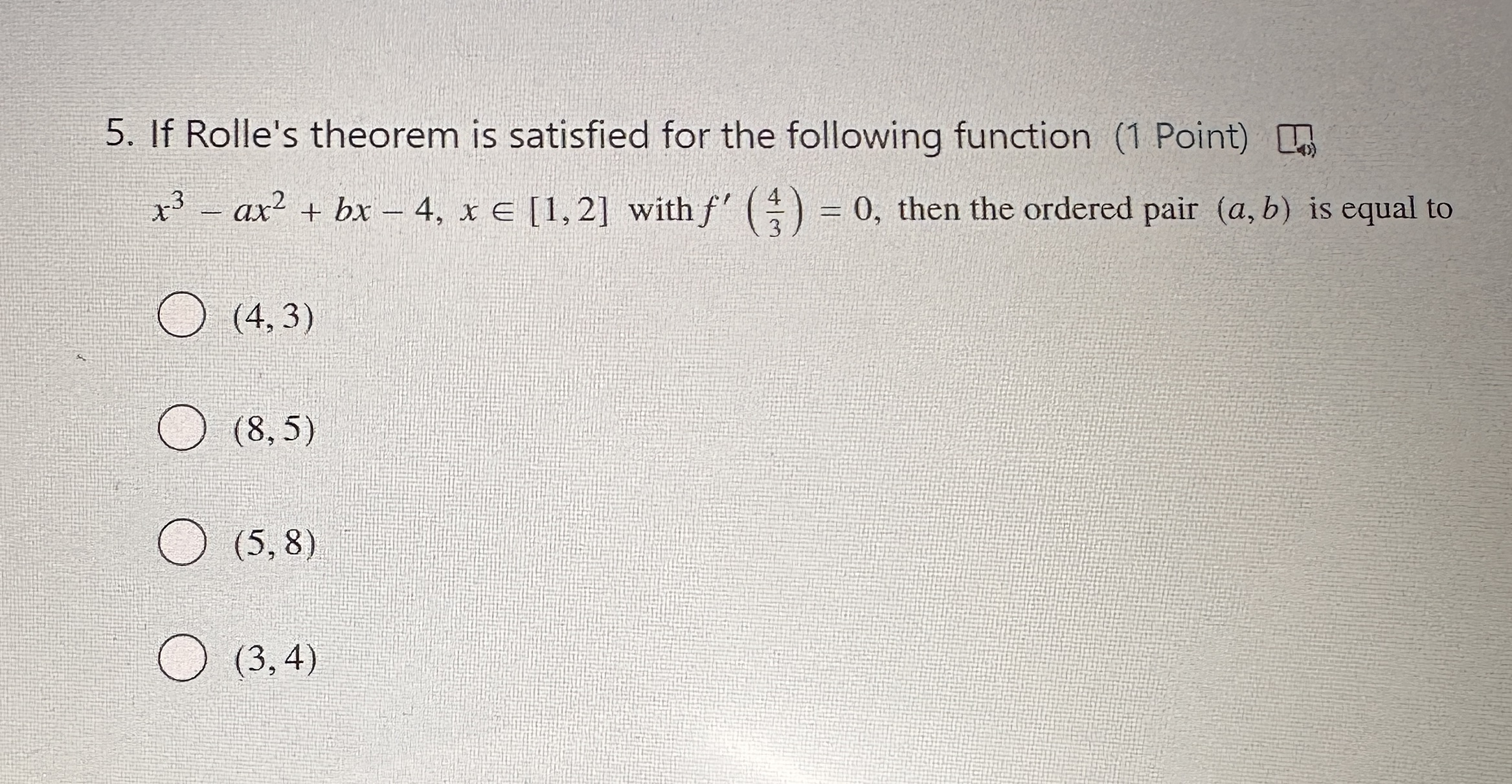If Rolle's theorem is satisfied for the following function x^3 - ax^2 + bx - 4, x in [1,2] with f'(4/3) = 0, then the ordered pair (a, b) is equal to.

Understand the Problem
The question is asking for the ordered pair (a, b) that satisfies the conditions of Rolle's theorem applied to the given function on the specified interval, along with the condition regarding the derivative at a specific point. This involves understanding the theorem, the role of derivatives, and the relationship between the values of a and b.
Answer
The ordered pair \( (a, b) \) is \( (5, 8) \).
Answer for screen readers
The ordered pair ( (a, b) ) is ( (5, 8) ).
Steps to Solve
-
Identify the function and its derivative We start with the function given by ( f(x) = x^3 - ax^2 + bx - 4 ).
-
Find the derivative of the function The derivative ( f'(x) ) is calculated as follows:
[ f'(x) = 3x^2 - 2ax + b ]
- Apply the condition f'(4/3) = 0 Substituting ( x = \frac{4}{3} ):
[ f'\left(\frac{4}{3}\right) = 3\left(\frac{4}{3}\right)^2 - 2a\left(\frac{4}{3}\right) + b = 0 ]
Calculating ( \left(\frac{4}{3}\right)^2 = \frac{16}{9} ):
[ f'\left(\frac{4}{3}\right) = 3 \cdot \frac{16}{9} - \frac{8a}{3} + b = 0 ]
This simplifies to:
[ \frac{48}{9} - \frac{8a}{3} + b = 0 ]
Multiply the entire equation by 9 to eliminate the fraction:
[ 48 - 24a + 9b = 0 \quad (1) ]
- Use Rolle's theorem conditions According to Rolle's theorem, since ( f(1) = f(2) ):
Calculate ( f(1) ):
[ f(1) = 1^3 - a \cdot 1^2 + b \cdot 1 - 4 = 1 - a + b - 4 = -a + b - 3 \quad (2) ]
Calculate ( f(2) ):
[ f(2) = 2^3 - a \cdot 2^2 + b \cdot 2 - 4 = 8 - 4a + 2b - 4 = -4a + 2b + 4 \quad (3) ]
Setting equations (2) and (3) equal to each other:
[ -a + b - 3 = -4a + 2b + 4 ]
Rearranging gives:
[ 3a - b - 7 = 0 \quad (4) ]
- Solve the system of equations Now we solve equations (1) and (4) simultaneously:
-
( -24a + 9b = -48 ) (from equation 1)
-
( 3a - b = 7 ) (from equation 4)
From equation (4), express ( b ):
[ b = 3a - 7 ]
Substituting into equation (1):
[ -24a + 9(3a - 7) = -48 ]
Distributing:
[ -24a + 27a - 63 = -48 ]
Combining like terms:
[ 3a - 63 = -48 \implies 3a = 15 \implies a = 5 ]
Substituting ( a ) back to find ( b ):
[ b = 3(5) - 7 = 15 - 7 = 8 ]
Thus, the ordered pair ( (a, b) ) is ( (5, 8) ).
The ordered pair ( (a, b) ) is ( (5, 8) ).
More Information
Rolle's theorem states that if a function is continuous on a closed interval and differentiable on the open interval, then there exists at least one point in the interval where the derivative is zero. This problem illustrates the application of Rolle's theorem to find specific coefficients in a polynomial function.
Tips
- Misunderstanding the conditions of Rolle's theorem: Ensure that the function meets the prerequisites of continuity and differentiability over the interval.
- Incorrectly substituting values: Be careful when substituting values into equations to avoid errors in calculations.
AI-generated content may contain errors. Please verify critical information